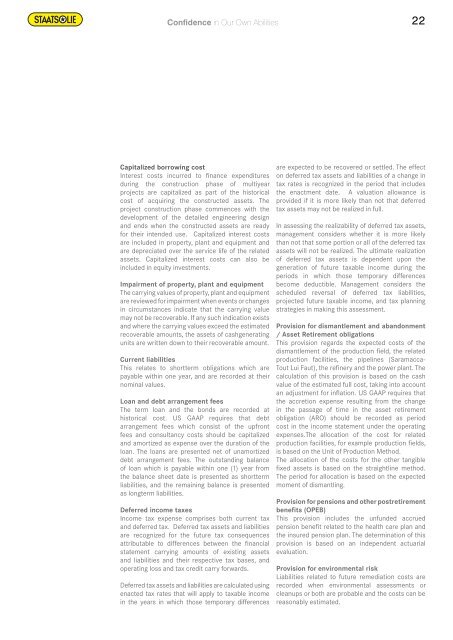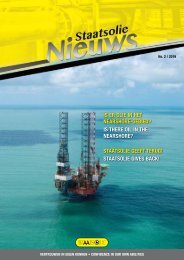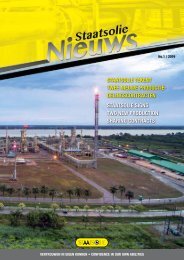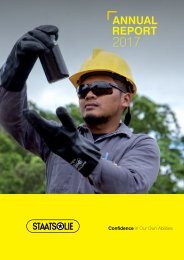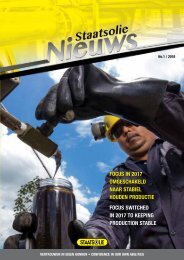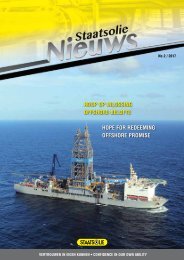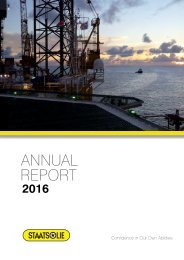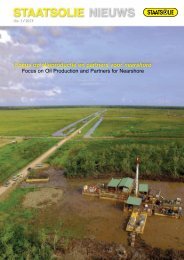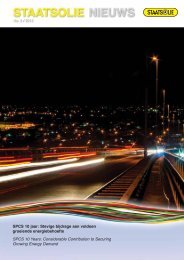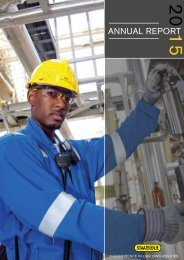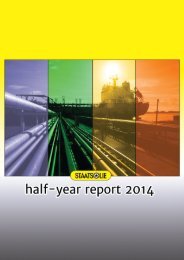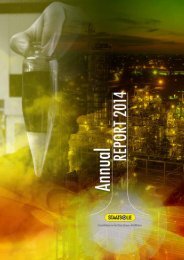Staatsolie Half-Year Report 2017
Create successful ePaper yourself
Turn your PDF publications into a flip-book with our unique Google optimized e-Paper software.
Confidence in Our Own Abilities<br />
22<br />
Capitalized borrowing cost<br />
Interest costs incurred to finance expenditures<br />
during the construction phase of multiyear<br />
projects are capitalized as part of the historical<br />
cost of acquiring the constructed assets. The<br />
project construction phase commences with the<br />
development of the detailed engineering design<br />
and ends when the constructed assets are ready<br />
for their intended use. Capitalized interest costs<br />
are included in property, plant and equipment and<br />
are depreciated over the service life of the related<br />
assets. Capitalized interest costs can also be<br />
included in equity investments.<br />
Impairment of property, plant and equipment<br />
The carrying values of property, plant and equipment<br />
are reviewed for impairment when events or changes<br />
in circumstances indicate that the carrying value<br />
may not be recoverable. If any such indication exists<br />
and where the carrying values exceed the estimated<br />
recoverable amounts, the assets of cashgenerating<br />
units are written down to their recoverable amount.<br />
Current liabilities<br />
This relates to shortterm obligations which are<br />
payable within one year, and are recorded at their<br />
nominal values.<br />
Loan and debt arrangement fees<br />
The term loan and the bonds are recorded at<br />
historical cost. US GAAP requires that debt<br />
arrangement fees which consist of the upfront<br />
fees and consultancy costs should be capitalized<br />
and amortized as expense over the duration of the<br />
loan. The loans are presented net of unamortized<br />
debt arrangement fees. The outstanding balance<br />
of loan which is payable within one (1) year from<br />
the balance sheet date is presented as shortterm<br />
liabilities, and the remaining balance is presented<br />
as longterm liabilities.<br />
Deferred income taxes<br />
Income tax expense comprises both current tax<br />
and deferred tax. Deferred tax assets and liabilities<br />
are recognized for the future tax consequences<br />
attributable to differences between the financial<br />
statement carrying amounts of existing assets<br />
and liabilities and their respective tax bases, and<br />
operating loss and tax credit carry forwards.<br />
Deferred tax assets and liabilities are calculated using<br />
enacted tax rates that will apply to taxable income<br />
in the years in which those temporar y dif ferences<br />
are expected to be recovered or settled. The effect<br />
on deferred tax assets and liabilities of a change in<br />
tax rates is recognized in the period that includes<br />
the enactment date. A valuation allowance is<br />
provided if it is more likely than not that deferred<br />
tax assets may not be realized in full.<br />
In assessing the realizability of deferred tax assets,<br />
management considers whether it is more likely<br />
than not that some portion or all of the deferred tax<br />
assets will not be realized. The ultimate realization<br />
of deferred tax assets is dependent upon the<br />
generation of future taxable income during the<br />
periods in which those temporary differences<br />
become deductible. Management considers the<br />
scheduled reversal of deferred tax liabilities,<br />
projected future taxable income, and tax planning<br />
strategies in making this assessment.<br />
Provision for dismantlement and abandonment<br />
/ Asset Retirement obligations<br />
This provision regards the expected costs of the<br />
dismantlement of the production field, the related<br />
production facilities, the pipelines (Saramacca-<br />
Tout Lui Faut), the refinery and the power plant. The<br />
calculation of this provision is based on the cash<br />
value of the estimated full cost, taking into account<br />
an adjustment for inflation. US GAAP requires that<br />
the accretion expense resulting from the change<br />
in the passage of time in the asset retirement<br />
obligation (ARO) should be recorded as period<br />
cost in the income statement under the operating<br />
expenses.The allocation of the cost for related<br />
production facilities, for example production fields,<br />
is based on the Unit of Production Method.<br />
The allocation of the costs for the other tangible<br />
fixed assets is based on the straightline method.<br />
The period for allocation is based on the expected<br />
moment of dismantling.<br />
Provision for pensions and other postretirement<br />
benefits (OPEB)<br />
This provision includes the unfunded accrued<br />
pension benefit related to the health care plan and<br />
the insured pension plan. The determination of this<br />
provision is based on an independent actuarial<br />
evaluation.<br />
Provision for environmental risk<br />
Liabilities related to future remediation costs are<br />
recorded when environmental assessments or<br />
cleanups or both are probable and the costs can be<br />
reasonably estimated.


